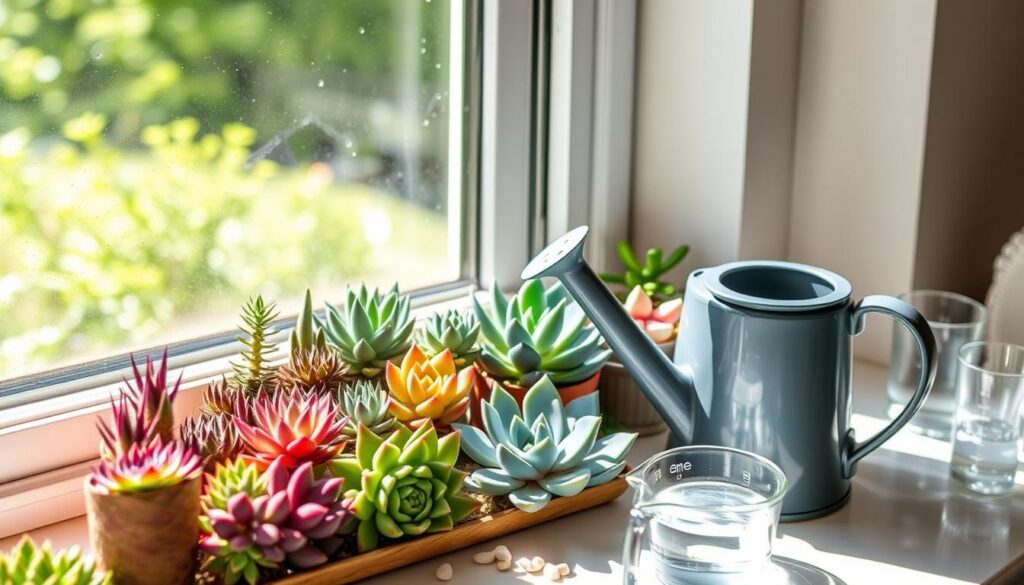Starting with indoor succulents, I often ask, how often should I water them? The key is to water based on soil moisture. Water when the soil is dry to the touch1. Finding the right watering schedule is vital for their health.
Watering indoor succulents isn’t just about how often. It’s also about how you do it. Indoor plants need more water than outdoor ones because they miss out on rain1. I’m eager to share my insights on the best watering methods for indoor succulents.
Key Takeaways
- Watering succulents should be based on soil moisture; water when the soil feels dry to the touch1.
- Indoor succulents may require more frequent watering compared to outdoor succulents due to lack of natural rainwater1.
- Indoor succulent watering schedule is key, and knowing the best routine is essential2.
- Avoid watering succulents at night to prevent excess water pooling, which can lead to issues like root rot1.
- Succulents generally need about 6 hours of bright, indirect sunlight each day when grown outdoors2.
- Use watering bottles for targeted watering of succulents, which helps avoid leaf wetness1.
Understanding Indoor Succulent Watering Basics
Watering is key in indoor succulent care. Succulents store water in their leaves, stems, and roots. This lets them live in dry places but means they need special care. To see if your succulent needs water, check the soil by inserting your finger up to the first knuckle. If it’s dry, it’s time to water.
70% of succulent owners say bad watering kills their plants3. Knowing how succulents store water is vital. They do well in places with little rain and long dry spells3. By mimicking this, you can help your succulents flourish.
Basic Watering Principles for Indoor Succulents
Water succulents when the top inch or two of soil is dry. This can be every 5 to 10 days, depending on the situation3. The size and type of succulent, along with the climate and soil, also matter. Larger succulents need more water than smaller ones4. By following these tips, you can keep your indoor succulents healthy and happy.
How Often to Water Succulents Indoors
Watering indoor succulents depends on several things. These include the size of the pot, the type of soil, and the room’s temperature5. Usually, succulents need water every 2-3 weeks in the summer5. But, the exact timing can change based on your home’s environment.
To figure out the right watering schedule for your succulents, think about a few key points:
- Pot size: Smaller pots need more water often5.
- Soil composition: Soil that holds water longer means you water less often5.
- Temperature: Warmer rooms might need more water5.
Creating a good watering plan is key to avoid drowning your succulents. This can cause root rot6. Always check the soil moisture, focusing on the bottom half of the pot5. Adjust how often you water based on what you find. By doing this, you can help your succulents thrive indoors.
| Season | Watering Frequency |
|---|---|
| Summer | Every 2-3 weeks5 |
| Winter | Every 3-4 weeks5 |
Signs Your Succulent Needs Water
To figure out if your succulent needs water, look for signs of underwatering. Wrinkled leaves are a clear sign that your succulent is thirsty7. Also, if the leaves feel soft and mushy, it’s because the succulent is storing water.
Testing the soil moisture is key to knowing when to water. You can use a wooden skewer or buy a soil moisture meter for better results7. Always water when the soil is dry all the way through, not just on top.
Here are some helpful tips:
- Regularly check the soil moisture to avoid too much water8.
- Water your succulent until water comes out of the pot’s bottom7.
- Use soil that drains well to avoid waterlogged soil8.
By following these tips and watching for signs of underwatering, you can keep your succulent healthy. Water when the soil is dry, and don’t overdo it to prevent health issues7.
| Signs of Underwatering | Soil Moisture Testing Methods |
|---|---|
| Wrinkled leaves | Wooden skewer |
| Soft, mushy texture | Commercial soil moisture meter |
Best Watering Techniques for Indoor Succulents
Understanding your indoor succulents’ needs is key. Succulents, being drought-tolerant, need less water than other houseplants9. The “soak and dry” method is best. This means soaking the soil fully before letting it dry out. This cycle can last from 1 to 4 weeks, depending on the environment9.
To water your indoor succulents right, follow these steps:
- Water when the soil is completely dry to avoid root rot, which happens in about 20% of cases when succulents get too much water9.
- Use a pot with a drainage hole to let excess water out9.
- Water less in winter, only when the bottom leaves start to shrivel10.
Think about your home’s temperature and humidity when watering. Higher temperatures mean you might need to water more, up to 50% more than in cooler places9. But, if it’s very humid, you might water less, by up to 30%, because the soil takes longer to dry9.
Using a soil moisture meter can help you avoid overwatering10. By following these tips and considering your plants’ specific needs, you can keep them healthy and vibrant.
| Season | Watering Frequency |
|---|---|
| Spring and Fall | Once weekly10 |
| Summer | Every 10 to 15 days10 |
| Winter | Watering sparingly10 |
Common Watering Mistakes to Avoid
Watering succulents right is key. Overwatering is a big no-no, causing root rot and other issues11. Always check the soil moisture before watering. Water only when it’s completely dry11.
Don’t underwater your succulents either. They can go longer without water than regular houseplants, but they need it11. How often you water depends on the pot size and the season. They usually need more water in spring and summer12.
Here are some tips to avoid common mistakes:
* Water succulents only when the soil feels completely dry11
* Avoid getting water on the leaves to prevent rot11
* Use a pot with a drainage hole to prevent standing water11
* Water succulents deeply but infrequently, mimicking the natural rainfall pattern13
By following these tips, you can help your succulents thrive. Enjoy their unique beauty12. Keep an eye on your succulents and adjust your watering schedule as needed13.
| Watering Mistake | Consequence | Solution |
|---|---|---|
| Overwatering | Root rot and other problems | Check soil moisture levels consistently and water only when necessary11 |
| Underwatering | Succulent stress and poor growth | Water succulents regularly, depending on pot size and time of year12 |
Choosing the Right Location for Indoor Succulents
When picking a spot for indoor succulents, think about the light they need. Most succulents do well in bright, indirect light. A spot near a window or under a skylight is perfect. If your succulent’s leaves are shrinking or puckering, it might not have enough light14.
It’s also important to avoid direct sunlight, which can burn them. Most indoor succulents love bright light, like near south- or east-facing windows, more so in winter in northern areas14. Here are some tips to get the light right:
- Place succulents near a window or under a skylight for bright, indirect light
- Avoid direct sunlight, which can cause burning
- Check for signs of insufficient light, such as shrinking or puckering leaves
Temperature and humidity are also key when picking a spot for your succulents. The right spot and conditions help them thrive and look beautiful15.
By following these tips, you can make your indoor succulent garden flourish. Choose the best spot, considering light and other needs, to ensure your succulents get the care they need.
| Location | Lighting Requirements | Temperature |
|---|---|---|
| Near a window | Bright, indirect light | 65-75°F (18-24°C) |
| Under a skylight | Bright, indirect light | 65-75°F (18-24°C) |
Seasonal Changes in Watering Needs
As a succulent owner, it’s key to know that seasonal succulent watering needs change with the seasons. In summer, succulents need more water, about every 10-15 days16. In winter, they need much less, maybe once every few weeks17.
To find the right summer watering schedule for your succulents, look at your area’s temperature and humidity. Succulents usually need water every 7 to 10 days from spring to fall when they’re growing17. But in winter, they only need water once every 3 to 4 weeks17.
Here are some tips for seasonal succulent watering:
- Water your succulents in the morning so the soil can dry a bit before night16.
- Use a soil moisture meter to avoid overwatering and make sure the soil is dry between waterings16.
- Bottom watering helps roots grow and keeps water out of the leaves16.
By following these tips and adjusting your summer watering schedule and winter watering adjustments as needed, you can make sure your succulents get the right amount of water to thrive.
| Season | Watering Frequency |
|---|---|
| Summer | Every 10-15 days16 |
| Winter | Once every few weeks17 |
The Impact of Light on Watering Requirements
Understanding how light affects watering is key for succulent care. More light means more water is needed18. This is because light speeds up water loss through transpiration.
Succulents need bright, indirect sunlight to grow well, with at least six to eight hours of light daily19. But, the lighting needs vary by species and habitat. Some succulents need direct sunlight, while others prefer shade.
To find the right watering schedule for your succulent, consider these factors:
- Species: Different succulents need different amounts of light, so research your plant’s needs.
- Light intensity: Succulents in direct sunlight need more water than those in indirect sunlight.
- Temperature: Warmer temperatures mean more water loss, so succulents in warmer places need more water.
By adjusting your watering based on light, you can help your succulent thrive. Watch how your plant reacts to different lights and adjust its care as needed20.

| Succulent Species | Lighting Needs | Watering Schedule |
|---|---|---|
| Aloe Vera | Bright, indirect sunlight | Water every 2-3 weeks |
| Echeveria | Indirect sunlight | Water every 2-3 weeks |
| Sedum | Full sun to partial shade | Water every 1-2 weeks |
Soil and Container Considerations
When growing indoor succulents, soil and container considerations are key. The right soil can greatly help your succulents thrive. A well-draining mix is vital, allowing for air and moisture21.
Use a pot with a hole for drainage and mix soil that’s one-third organic and two-thirds mineral22. This setup helps prevent root rot, a common issue with succulents.
Drainage is critical for succulents. They can rot if the soil stays too wet. Choose a container that lets air in and has a hole for water to drain. Consider size, material, and drainage when picking a container.
- Choose a container that is slightly larger than the plant’s root system
- Select a material that allows for good airflow, such as terracotta or ceramic
- Ensure the container has a drainage hole to prevent waterlogged soil
By picking the right soil, drainage, and container, you can create a perfect home for your succulents21. Remember, different succulents have different needs. Some might need more water or special care22.
Temperature Effects on Succulent Care
Temperature is key in caring for succulents. Most succulents do best in temperatures between 65-75°F (18-24°C). If the temperature is too high or too low, it can harm the plant and change how often it needs water23.
Succulents can grow well in temperatures from 60 to 80 degrees Fahrenheit24. But, they usually prefer temperatures below 90 degrees Fahrenheit25. It’s important to know what your succulent needs and adjust the temperature to meet those needs.
Here are some important things to remember about temperature and succulent care:
- Give new succulents shade to help them get used to sunlight25
- Make sure colorful succulents get at least 6 hours of bright, indirect sunlight every day25
- Don’t let succulents get too cold, below freezing (32 degrees Fahrenheit) for too long25
By knowing how temperature affects succulents and following these tips, you can give your succulents the best care. This will help them grow and thrive in their environment.
Recognizing and Treating Water-Related Problems
As a succulent owner, it’s key to spot water issues early. Look out for signs of overwatering like soft leaves and soggy soil26. If you see these, it might mean root rot. To fix it, cut off the bad roots and put the plant in new, dry soil27.
To avoid these problems, use pots with holes and check soil moisture by feeling it26. Water less in cooler months when plants are less active26. Watering from the bottom helps the roots get what they need27.
- Check the soil moisture regularly to avoid overwatering26.
- Use a well-draining soil mix to prevent waterlogging27.
- Prune damaged parts of the succulent to prevent further infection26.
By following these tips, you can keep your succulents healthy. Watch for signs of overwatering and act fast26. With the right care, your succulents will thrive, and you’ll enjoy their beauty and easy care27.
Conclusion: Mastering Indoor Succulent Care
Learning to care for indoor succulents is a journey. It’s about finding the right balance of water, light, and temperature. These plants need the right care to grow well in our homes28.
Watering is key, and it depends on several factors. You should water every 1-3 weeks, based on light, temperature, and humidity28. Always check the soil 2 inches down to see if it’s dry before watering again28.
Light is also vital for your succulents. They need at least six hours of bright, indirect sunlight daily28. With good light, they’ll grow strong and show off their colors29. Echeverias, for example, do best in temperatures between 65-80°F (18-27°C) and can handle cooler temperatures down to 40°F (4°C).
By learning the basics of indoor succulent care, you can create a beautiful oasis. Patience and careful attention are key. With the right care, you’ll become a skilled succulent caretaker.




